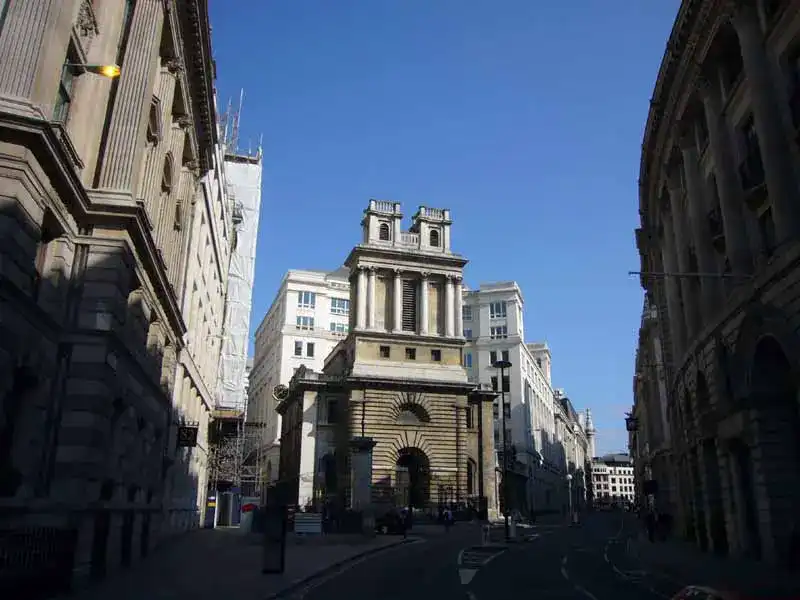Nicholas Hawksmoor Architect, English church building photos, England religious design pictures
Nicholas Hawksmoor Architect : Church Architecture
18th Century English Architecture Practice, London, UK
28 October 2024
Blenheim Palace building restoration, Woodstock, Oxfordshire, Southern England, UK
Original Architects: John Vanbrugh, Nicholas Hawksmoor
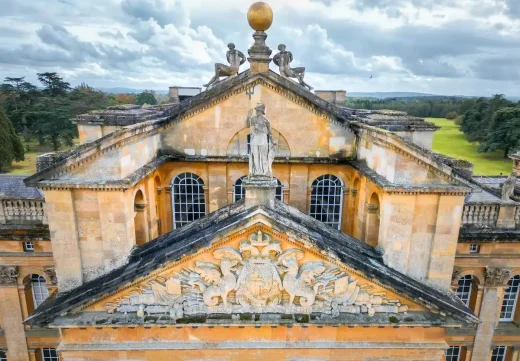
photograph : Carmel Jane
Blenheim Palace building restoration
28 August 2024
Hélène Binet to participate in a new Hawksmoor exhibition
An exhibition at the landmark Hawksmoor masterpiece of St Anne’s Limehouse from 14th September 2024 to 14th March 2025 will offer visitors a rare opportunity to view works by Hélène Binet previously shown at the Venice Biennale. Binet, whose name is more usually associated with leading contemporary architects and whose work was the subject of a major retrospective at the Royal Academy in 2021, created a series of photographs depicting the 18th century London churches designed by Nicholas Hawksmoor. She is exhibiting works from this series at St Anne’s Limehouse in support of their Hawksmoor300 campaign to restore this architectural icon and to open it up as a cultural and community hub.
The Hawksmoor6 exhibition launches at St.Anne’s Limehouse
The exhibition, entitled The Hawksmoor6 presents the stories of the six Hawksmoor churches’ survival over the past 300 years, -in sharp contrast to so many of Christopher Wren’s masterpieces which have been lost. These churches have faced ruinous fire, WW2 bombing, threats of demolition, disregard and neglect.
And yet they are still standing.
This is invariably due to the efforts of small groups of individuals. At various junctures architects, authors, artists, arts administrators, clergy, academics and volunteers from local communities came together to successfully campaign and preserve these buildings, often working with heritage organisations. The media played a central part in publicising the campaigns. The November 1962 edition of Vogue included a fashion shoot at Christ Church and St Anne’s with a shout out for support.
In 1977 the Whitechapel Art Gallery launched a Hawksmoor show. A new film for the exhibition includes an interview with Nicholas Serota, Chair of the Arts Council England and former Director of the Whitechapel Art Gallery (1976-88).
He says,
“The immediate effect of the Whitechapel exhibition was to bring together a group of people who wanted to restore and bring back into use Christ Church Spitalfields. The other churches in the area remained somewhat neglected especially St Anne’s…”
St Anne’s has, perhaps, been the most overlooked and under-valued of the six masterpieces. It is found in the most deprived area of London, in the borough with the worst levels of child poverty in the country. The proposals for its restoration include a firm commitment to the Tower Hamlets local community.
“St Anne’s Limehouse is one of the largest and grandest of the Fifty New Churches, originally on the edge of a small, ship-building village, now at the heart of East London. It deserves to be, as it was planned to be, a great gathering place for the its local communities”
– Charles Saumarez Smith, art historian and former Director of the Royal Academy
“Hélène Binet is one of the world’s most distinguished architectural photographers and her Hawksmoor series, by focusing on moody details of his austere baroque churches, and the play of light and shadow on their stone surfaces, successfully conveys the intensity of a spirit of place. It is wonderful that, in exhibiting at St. Anne’s Limehouse, she is supporting the Hawksmoor300 campaign to save this extraordinary building and make it a place where the arts can flourish.”
– Christopher Turner, Keeper of Art, Architecture, Photography and Design at the V and A
“This exhibition is about bringing people together in this previously overlooked Hawksmoor masterpiece. Come for the unique opportunity to view Hélène Binet’s stunning work in this extraordinary setting, come to learn more about our Hawksmoor300 campaign, come to investigate the past, present and future of this enduring, yet vulnerable, East End landmark.”
– Jude Reddaway, Curator of The Hawksmoor6
The Hawksmoor6 exhibition will include the architectural firm Thomas Ford’s proposals and designs for the restoration and Br!l Consultancy’s plans for community engagement based on their research workshops with local residents. Students from Barlett School of Architecture will exhibit work from their Architecture & Historic Urban Environments Programme featuring St Anne’s.
The Hawksmoor6 exhibition opens its doors for Open City week, starting Saturday 14th September through to Saturday 21st September 10-4 excluding Sunday but open late on Friday 20th until 8.
Thereafter the exhibition is open Fridays and Saturdays 10-4
Previously on e-architect:
post updated 20 Apr 2021
Major Nicholas Hawksmoor Building
Christ Church, Spitalfields, east London, England, UK
Date built: 1715-29
Design: Nicholas Hawksmoor Architect
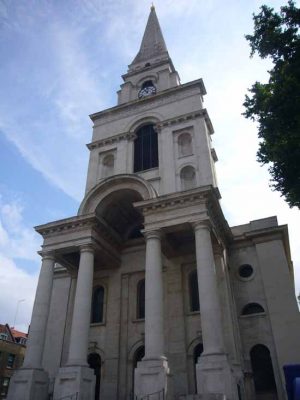
photo © AW
Christ Church Spitalfields : major London church building
Christ Church was built between the years 1714 and 1729 as part of the church building programme initiated by the Fifty New Churches act of 1711, backed by Queen Anne, which was implemented by four different Commissions.
At the time, there were fears that ‘godless thousands’ outside the City of London had no adequate church provision, and that non-conformists – including large numbers of French Huguenot silk weavers – were moving into Spitalfields and bringing their non-conformist worshipping ways with them.
The Commission appointed to build the 50 new churches stipulated that the new buildings should have tall spires so that they would tower above the smaller, non-conformist chapels! The idea was to fund the work through taxes on coal coming into London, although monies ran low in about 1719 and building progressed fitfully.
Key Nicholas Hawksmoor Architecture
Nicholas Hawksmoor Buildings
St George’s Church, Bloomsbury, central-north London, England, UK
Date built: 1716-30
This building was restored in 2006
Design: Molyneux Kerr Architects
St Mary Woolnoth, City of London
Date built: 1716-24
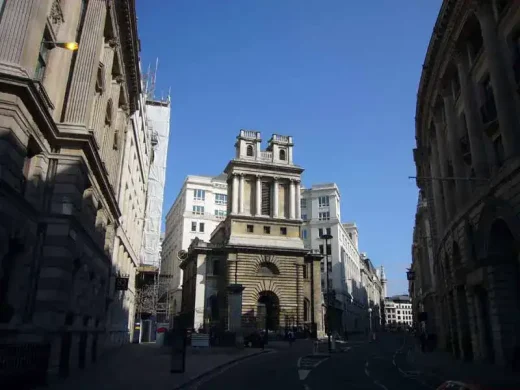
photo © Adrian Welch
St Mary Woolnoth
St. Mary Woolnoth is an Anglican church in the City of London, located on the corner of Lombard Street and King William Street near Bank junction. The present building is one of the Queen Anne Churches. The present building is at least the third church on the site. It is considered one of his most distinctive and original designs by this architect. It is the architect’s only City of London church. Its unusually imposing façade, in English Baroque style, is dominated by two flat-topped turrets supported by columns of the Corinthian order, which are used throughout the church.
Easton Neston, Northamptonshire, central England, UK
Dates built: 1695-1702/10
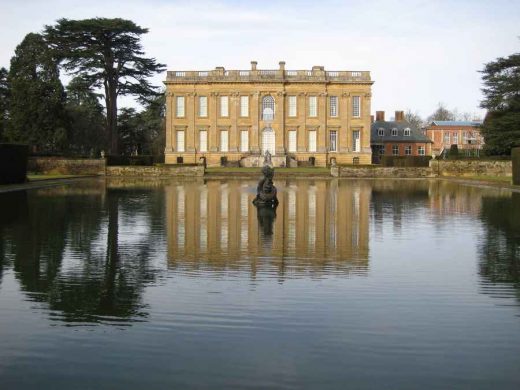
photograph from RIBA
Easton Neston
Easton Neston is one of the finest country houses in England, designed by the architect with an adjacent wing by Christopher Wren. Refurbished by Ptolemy Dean Architects.
St. George-in-the-East, Wapping, Stepney, East London, England
Dates built: 1714-29
St Alfege’s Church, Greenwich, southeast London, England
–
St Anne’s Limehouse, east London, England
Dates built: 1727
St Anne’s Limehouse is an Anglican Church in Limehouse, in the London Borough of Tower Hamlets. It was consecrated in 1730, one of the twelve churches built through the 1711 Act of Parliament.
The building was designed as one of twelve churches built to serve the needs of the rapidly expanding population of London in the 18th century. The scheme never met its original target, but those built were also known as the Queen Anne Churches.
Westminster Abbey – west towers, Whitehall, Westminster, central London, SW1
–
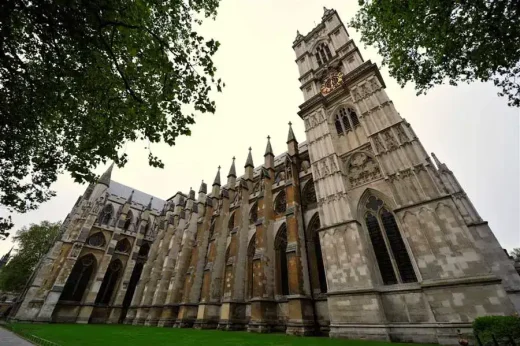
photograph © Nick Weall
Westminster Abbey Building
Grade I Listed
More Nicholas Hawksmoor buildings online soon
Nicholas Hawksmoor – Key Roles
Hawksmoor worked with Christopher Wren on the following buildings:-
Chelsea Hospital
Greenwich Hospital
Hampton Court Palace
St Paul’s Cathedral
Key roles:
– Clerk of Works on Kensington Palace
– Deputy Surveyor of Works at Greenwich
– Surveyor of Works at Westminster Abbey from 1723 after Christopher Wren
The architect worked for John Vanbrugh on the following buildings:-
Blenheim Palace (later working direct)
Castle Howard
Other Nicholas Hawksmoor Buildings
All Souls College Oxford: Codrington Library + new buildings
Clarendon Building, Oxford
Ockham House remodelling
Queen’s College Oxford : High Street Screen
Worcester College buildings
More architecture projects by this British architect online soon
Location: London, England, UK
Historic English Architect Practice Information
Nicholas Hawksmoor – the Architect
Dates: 1661-1736
London churches : major historic buildings in the UK capital city
Hawksmoor is regarded by most people as being one of England’s greatest architects alongside Sir Christopher Wren and Sir John Vanbrugh.
Nicholas was born in Nottinghamshire. Early in his career he worked for Christopher Wren. Later he worked as an architect for John Vanbrugh on Castle Howard in 1699 and then Blenheim Palace, both in England.
The Nicholas Hawksmoor style was more robust and stark than Wren’s delicate and ornate tradition. St George’s Church for example is strongly articulated and seems more concerned with the modelling of form than refinement of decoration prevalent amongst many of his peers. Nicholas was in my view a very bold and talented figure and deserves to be better known amongst non-architects.
Church Buildings
London Architectural Designs
London Architecture Designs – chronological list
London Architecture Designs – architectural selection below:
60 Aldgate, Minories, City of London
Design: ACME, Architects
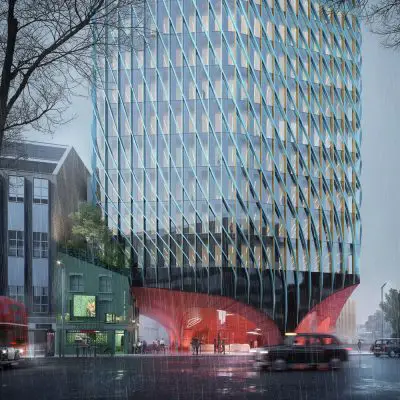
image courtesy of architects practice
60 Aldgate Building News
Buildings / photos for the Nicholas Hawksmoor Architect – 17th and 18th Century British Church Designer page welcome.

